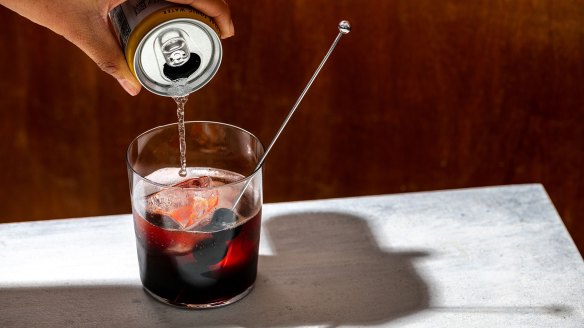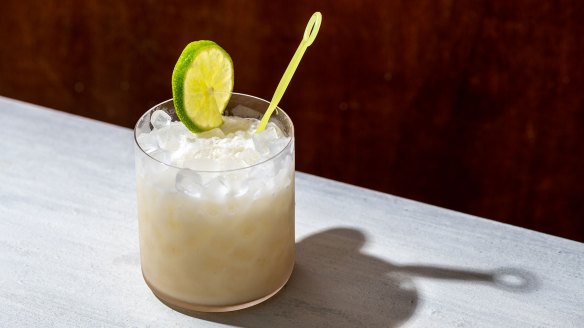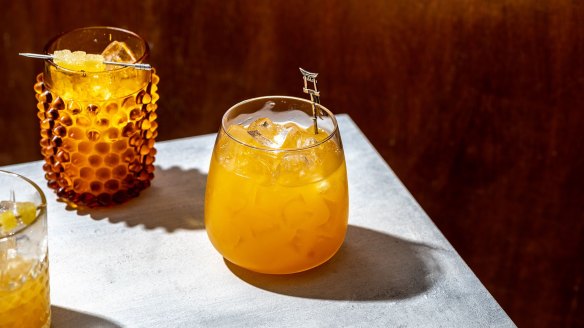No alcohol, no problem: How to make complex, balanced zero-proof cocktails

A new era of moderation seems to be upon us, with people - especially you healthy, clean-living millennial types - drinking less overall and having lighter forms of booze when they do drink.
The current trend seems to be driven by factors as diverse as physical and mental-health concerns, access to increasingly legal marijuana and the #MeToo movement's bringing back to the fore old arguments about the role alcohol may play in abusive behaviour.
New products are chasing this trend, some delicious, some atrocious, some - like the trendy non-alcoholic botanical spirit Seedlip - that can charm or vanish, depending on the rest of the drink. Meanwhile, bars catering to non-drinkers are popping up to welcome the sober and the "sober curious", driven by "sober influencers", a term that encapsulates our cultural moment, in which it's sometimes difficult to find the line between genuine goodness and the performance of it.
I tease, but even in the cocktail world, words matter. Many have concluded that the word "mocktail", which describes a booze-free cocktail, suggests a lesser drink or a lesser drinker. These days, you're more likely to see terms such as "zero-proof", "spirit-free" and the like. I'm less a fan of terms such as "virtuous" and "guilt-free"; there's just too much history of people, especially lady people, being guilt-tripped over innocent pleasures, and we should save our shaming for where it's needed.
For years, non-drinkers were the vegetarians of the bar world: neglected by menus, eye-rolled by servers, forced to settle for soda. The few non-alcoholic drinks available tended to taste as if they had been siphoned from a kindergarten juice pouch.
Today, while not every bar can be Existing Conditions, the cocktail lounge in New York that has put complex non-alcoholic cocktails up top on its menu, any bar (or host) worth their rimming salt should have a go-to option, something better than a random tonic with a muddle of random fruit (those deserve the term "mocktail").
For years, non-drinkers were the vegetarians of the bar world: neglected by menus, eye-rolled by servers, forced to settle for soda.
A hurdle the industry hasn't fully surmounted is how to make a bar into a place that someone who's not drinking still wants to go, says co-owner Dave Arnold, author of the James Beard award-winning cocktail book Liquid Intelligence. A bar that provides bespoke cocktails for drinkers and throws Diet Cokes at the sober isn't doing that.
"The message we want to send is that you are as important to us if you don't drink alcohol as if you do," he said.
How do you make a good non-alcoholic drink? Here are some tips:
1. Get better with bitter. This flavour acts as an appetite stimulant, so its presence may help a non-alcoholic cocktail play the role that traditional aperitifs do.
But it's also a challenge. Aromatic cocktail bitters, one of the easiest means to add bitterness, are almost always alcoholic, but they're used in such tiny portions that they can still be a good tool. Someone who's not drinking because they're driving may be fine with a few dashes, but someone avoiding alcohol completely will not, so if you use them, you'll want to be sure the drinker approves.
2. Taste for texture. The viscosity conferred by sugar or gomme syrup, the astringent qualities of the tannins in wines that can be echoed with teas and herbal concoctions, the froth of egg-white: All can help create a sort of trompe la bouche, reminding your palate of the textures and sensations of cocktails.
Arnold spoke of the tickle in the back of the throat that comes with some drinks. "It's a product of fermentation, and that's one of the things we replicate," using plant extracts and teas to create a similar mouthfeel. Existing Conditions often uses glycerin for viscosity without a massive boost in sweetness and a combination of acids to create flavour reminiscent of champagne.
3. Find a new hook. Intensity may be the quality that I've found hardest to replicate in spirit-free drinks: the mouthfeel of a beverage that contains a spirit and makes people drink a cocktail differently. Drinks writer Camper English noted that he uses the word "slow" to talk about what makes good non-alcoholic drinks - "something bitter or spicy or weird that makes you sip rather than gulp".
I think that's right on, but I've found that "something" can also be a trapdoor: In trying to echo the heat of alcohol, it's easy to overcompensate with an aggressive hook that skews a drink out of balance, making it too bitter, spicy or sour. Shrubs, drinking vinegars that evolved from old preservation techniques, are everywhere these days. Mix vinegar with fruit and sugar and you can get something delicious; you can also get something truly vile, in which the vinegar makes your eyes water before you even sip.
Drinks writer Kara Newman put it best, tweeting in response to my social media query, "Zero-proofs used to always be too sweet. Now so many are acid bombs ... I've left so many overvinegared drinks unfinished. Salad dressing in a glass, undrinkable."
4. Don't overthink it. In my testing, I kept returning to the qualities that make a good "regular" cocktail. It's not just what's in the glass, but the entire experience, a mysterious brew of flavours and aesthetics and atmosphere - that last element as relevant for the home host as it is for bars, even if home guests are (hopefully) less likely to ding you on Yelp.
When you can give all of your guests drinks that are delicious, balanced and attractive, assembled with care and high-quality ingredients, and served with warmth, then you've hit the hospitality sweet spot. Because it's not about the booze; it's about making people happy.

Three recipes to try
The Nilsson:
As the song says, put the lime in the coconut, and drink 'em both up - just add a bit of allspice. This drink is a boozeless mash-up of a daiquiri and a pina colada. If you can't find Dale DeGroff's pimento bitters, Angostura bitters have a similar flavour profile and make a decent substitute. Try slicing a couple of wheels of jalapeno or Thai chile into the shaker for a spicier version.
1 serving
For the drink: Ice (cubes for shaking and crushed ice for the drink), 60ml fresh lime juice (from about 2 limes), 30ml coconut cream, 2 dashes pimento bitters, Lime wheel, for garnish
Make the drink: Fill a rocks glass with crushed ice. Fill a cocktail shaker two-thirds of the way with ice cubes, then add the lime juice, coconut cream and bitters. Shake hard, about 15 seconds, then strain into the glass of crushed ice. Garnish with the wheel of lime.

No-Booze Penicillin:
The Penicillin, bartender Sam Ross's blended Scotch cocktail, has become a modern classic, known for its rich, spicy balance of flavours. This non-alcoholic riff picks up many of the original drink's notes, substituting rich, smoky lapsang souchong black tea for the Islay whisky in the original. Lapsang souchong tea is available at many gourmet markets and online. Note that this drink contains caffeine. You can prep this drink up to two days in advance; refrigerate it until you're ready to serve, and shake it before pouring.
10 to 12 servings
For the drink: 3 tablespoons loose-leaf lapsang souchong tea, 3 cups boiling water, 3 tablespoons fresh minced ginger root, 1 cup honey, 230-295ml fresh lemon juice (from about 6 lemons), ice, candied ginger (optional), for garnish
Make the drink: In a teapot or heat-proof bowl, infuse the tea in the boiling water. Let steep for about 4 minutes, then strain out the leaves. Add the ginger and honey to the tea, stirring gently until the honey is dissolved. Allow the mixture to infuse for 15 to 30 minutes, then strain out the ginger, pressing gently on the solids to squeeze out any remaining liquid. You should have about 3½ cups of liquid. Add 180ml lemon juice, then taste and add more until the balance of sour, sweet and spicy is to your liking. Refrigerate the drink until ready to serve. Serve the drink over ice, garnished with a slice of candied ginger.
Cherry Vamp:
A nearly zero-proof valentine of sour cherries and bitter chocolate. The "nearly" is because most aromatic bitters are alcoholic infusions, but they're used in such small doses many consider them fair game in creating non-alcoholic drinks. That said, if your aim is a completely dry cocktail, this isn't your drink. The simple syrup can be refrigerated in an airtight container for up to 6 months. Tart cherry juice is available in many grocery stores. This recipe uses chocolate bitters, which are widely available in good spirits stores and online, but you can substitute Angostura, if need be.
1 serving
For the simple syrup: 1 cup sugar 1 cup water
For the drink: Ice (preferably one large cube), 60ml tart cherry juice, 7ml simple syrup (15ml if you prefer a sweeter drink), ½ teaspoon chocolate bitters or Angostura bitters, 30-60ml tonic water, maraschino cherries or a star anise pod (optional), for garnish
Make the simple syrup: Combine the sugar and water in a small saucepan over medium-high heat. Bring just to a boil; once the sugar has dissolved, remove from the heat. The yield is about 1 cup. Cool completely.
Make the drink: Put a large ice-cube in a rocks glass. In a mixing glass, stir together the bitters, cherry juice and simple syrup. Pour over the large ice cube and top with a generous splash of tonic water. Garnish with a cocktail pick of cherries or a star anise pod.
The Washington Post